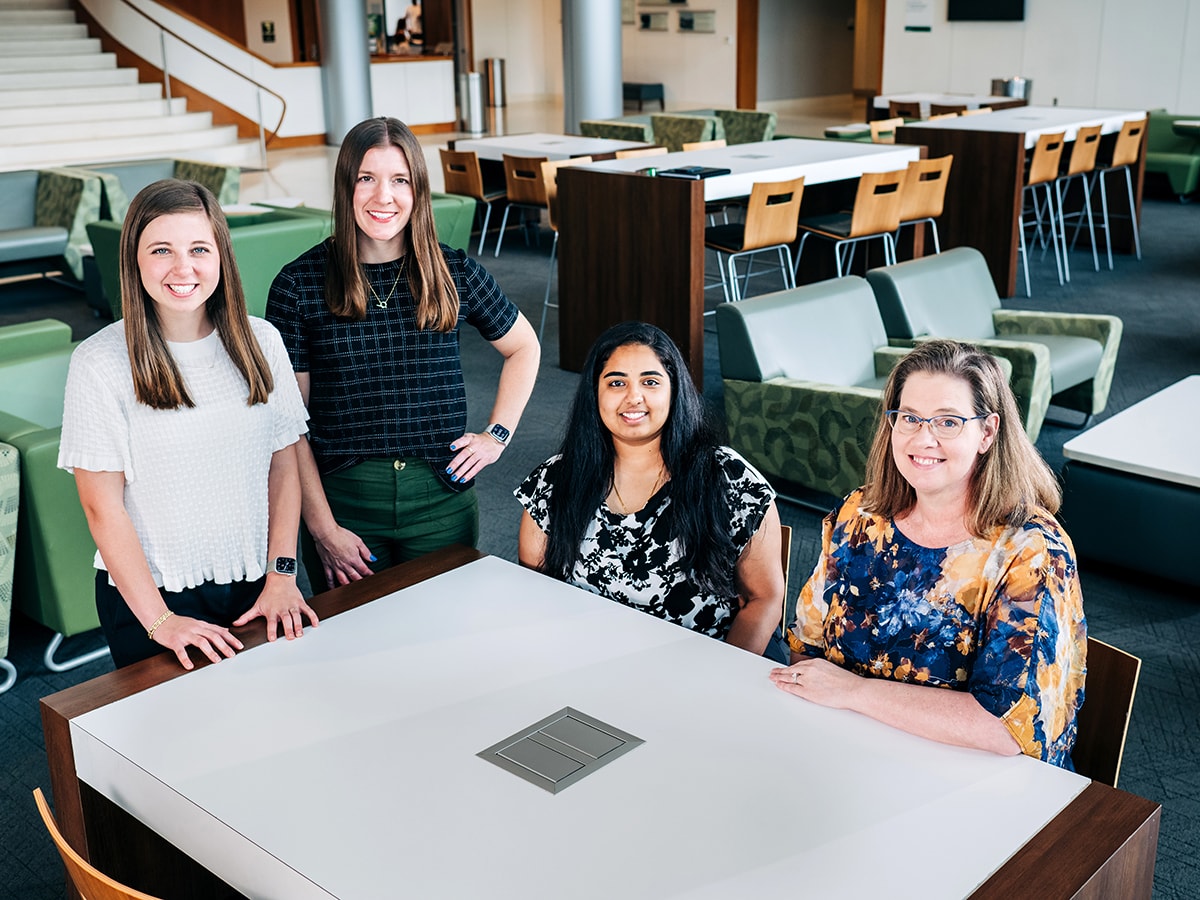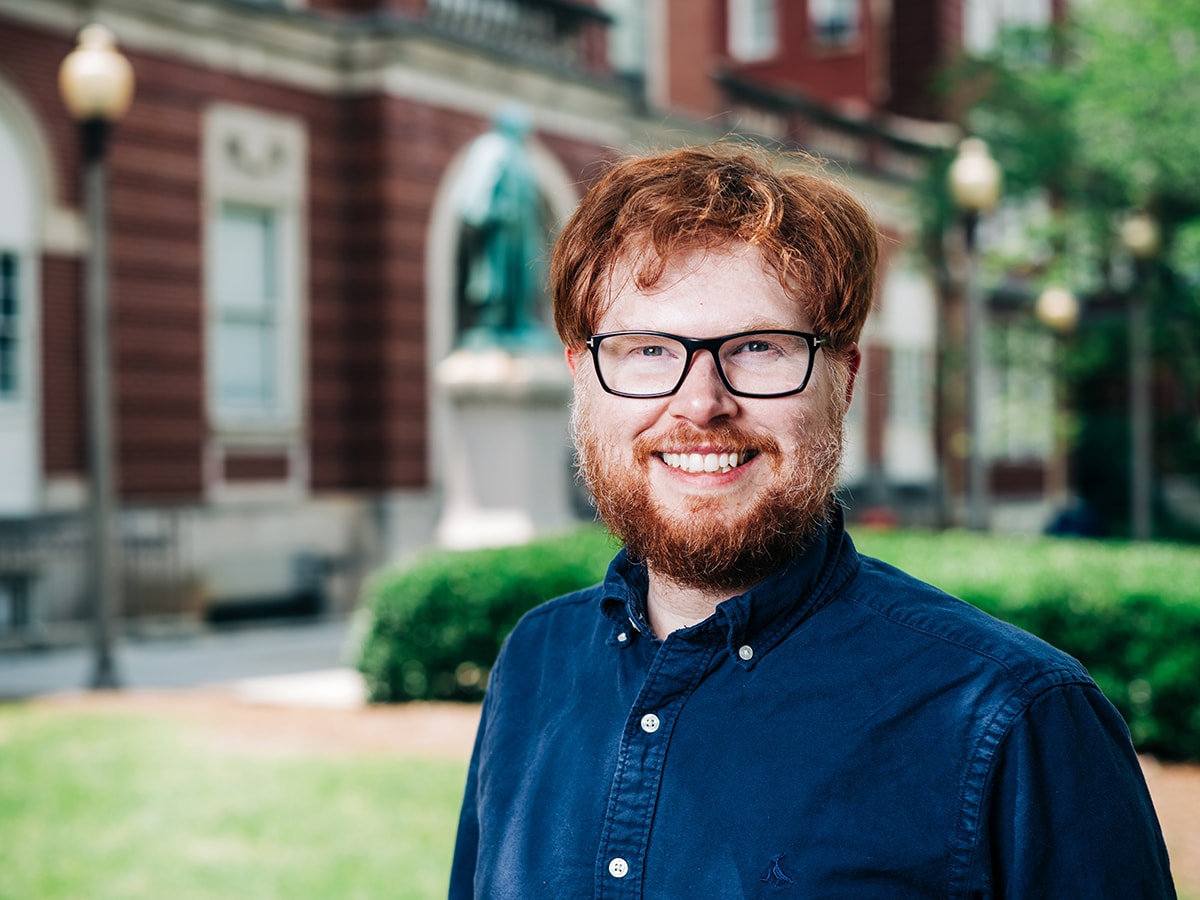 Cori Perdue, Ph.D. (right) with, left to right, Haley Nolen, Hannah Broom and Shivani Palaparthi at the Collat School of Business. Their project, tentatively titled the DISCovery Communication Coaching App, helps users better recognize different communication styles and tailor their messaging accordingly. Try it here.
Cori Perdue, Ph.D. (right) with, left to right, Haley Nolen, Hannah Broom and Shivani Palaparthi at the Collat School of Business. Their project, tentatively titled the DISCovery Communication Coaching App, helps users better recognize different communication styles and tailor their messaging accordingly. Try it here.
Photo by Andrea Mabry, UAB Marketing and CommunicationsFor a year or more, Cori Perdue, Ph.D., and her team in Collat Professional Education had been tossing around an idea for an interactive experience to improve workplace communication. The trouble was that turning their concept into a business plan and producing a working prototype would take time and money.
A team led by Ryan Melvin, Ph.D., had already created a generative AI software tool that was in active use in his department, had been the subject of journal publications and generated interest whenever he demoed it at conferences. The potential was obvious. But, like Perdue, Melvin wanted to find out: Was there commercialization potential?
Over the past few months, Perdue, executive director of Collat Professional Education in the School of Business, and Melvin, an associate professor in the Department of Anesthesiology and Perioperative Medicine in the Heersink School of Medicine, have been exploring answers to that question.
They are part of the first cohort of UAB’s Blazer App Accelerator program. Launched last fall by the UAB Harbert Institute for Innovation and Entrepreneurship and Birmingham-based Harmony Venture Labs, which is led by alumnus (and serial entrepreneur) Shegun Otulana, the program aims to jumpstart software innovation at UAB. Eleven participants, representing faculty and staff from across campus, were selected in January 2025. Over the past several months, the group has progressed through Harmony Venture Labs’ AppThink entrepreneurship curriculum, which involves validating their ideas and creating prototypes. After they finish this summer, the cohort members are encouraged to apply for HIIE’s Blazer Bridge Fund. Winning an award from the fund would give them $50,000 to complete the next stage of development for their projects.
“Let’s give it a shot”
“When we saw this opportunity, we said, ‘Let’s give it a shot,’” Perdue said. Her project involves the well-known DISC personality assessment (so named because its four components are Dominance, Influence, Steadiness and Conscientiousness).
The team in Collat Professional Education offers leadership training academies and workshops for executives and teams inside and outside UAB. In these sessions, they often use the DISC assessment to explore different communication styles in the workplace. (UAB Learning and Development offers regular workshops for employees interested in taking the DISC assessment.)
Try the DISCovery Communication Coaching App from Perdue's team here.
“Most people take the assessment online, get a 30-page report, show up to a workshop and say, ‘That’s cool!’” Perdue said. But after they leave the workshop, it can be difficult to figure out how to put this information into daily use. “We think there is a gap in having people practice making sure they really understand the DISC and then applying it in the real-world application of talking with each other, electronically or in person,” Perdue said.
Her initial idea was to use virtual reality to give users practice in engaging in conversations with people who have different communication styles. But the AppThink curriculum emphasized that a simpler approach would be better to begin with.
“They challenged us to not fall in love with our solution, but with a problem,” Perdue said. “You have to think through how to solve it and take it to market. We really spent time diving into the nitty-gritty of our ideas and making sure we have the right framework and the right foundation.” One of their homework assignments was to interview potential customers — not to pitch their product, but instead to “validate that this is a problem that really exists,” Perdue said.
Now, “we have pivoted, and largely from what we learned in the class, we are going to start with a web app,” Perdue said — tentatively titled the DISCovery Communication Coaching App. “We learned it would be smarter for us to start more simply and move to the next step once we get the kinks more worked out.”
Perdue and her co-inventors — Shivani Palaparthi, Hannah Broom and Haley Nolen — have worked as a team throughout the creative process and content development. Palaparthi, a graduate of UAB’s computer science master’s program, led the technical build of the app, which features an AI-powered coach that helps users better recognize different communication styles and tailor their messaging accordingly, Perdue says.
Users can write a draft of an important message (asking their boss for a raise or assigning a project to a team member, for example) and get detailed feedback on how well it will resonate with a given DISC communication style, along with suggestions for improvement. The app includes practice scenarios to test users’ ability to recognize different DISC styles and another tool that helps them learn how to take different communication and behavioral styles into account when delegating assignments.
Perdue encourages members of the Blazer community who are interested in participating in a limited beta test of the DISCovery Communication Coaching App to try it out here.
Truthful AI summaries — and podcasts
 Ryan Melvin, Ph.D., and his team have developed a number of tools, including AI-powered text summaries of new research papers as well as podcast-style audio summaries. Anyone with a BlazerID can test the tools here.
Ryan Melvin, Ph.D., and his team have developed a number of tools, including AI-powered text summaries of new research papers as well as podcast-style audio summaries. Anyone with a BlazerID can test the tools here.
Photo by Jennifer Alsabrook-Turner, UAB Marketing and Communications
Melvin already had a working tool when he applied to the Blazer App Accelerator program. Ever since he joined the Department of Anesthesiology in 2020, Melvin has been developing machine learning and AI-based software as part of team efforts in the department that have also included collaborations with other departments, including Radiology and Emergency Medicine. One example is a model that can predict a patient’s likelihood of complications after leaving a post-anesthesia recovery unit following surgery (see a publication on the model here).
Melvin saw potential for generative AI tools like ChatGPT to help busy clinicians, especially new residents, keep up with the latest research in their subspecialties — if they could trust the results of AI-powered summaries. Melvin worked with Ryan Godwin, Ph.D., an assistant professor in the department, and multiple clinical and research collaborators/champions to develop a tool that identifies and summarizes the top new papers in a field, “in a way that guarantees citations are accurate,” he said. Then they added functionality to allow users to create short podcast-style audio summaries of papers — so they could catch up on the latest studies, even on the go. (Anyone with a BlazerID can test the tools, which operate on UAB-approved resources, at ai.anes.uab.edu. The link also includes a page on the relevant policies for their usage.) “We could not have done any of this without the support of Anesthesiology IT and the robust infrastructure they have created within our department,” Melvin said.
Try the AI tools by Melvin and colleagues at ai.anes.uab.edu.
Department faculty now regularly use the tool with medical students, and it gets high praise from residents. “Whenever we take it to conferences, the No. 1 question we get is, ‘Can I use this right now?’” Melvin said. He saw the Blazer App Accelerator program as a way to explore other use cases for the tool and to learn more about how to make a business case for expanding it. “We have users — we wanted to see if we could get customers,” Melvin said.
The “Foundations” course from Harmony Venture Labs, the first part of the AppThink program, included helpful exercises designed to stretch participants’ thinking about their projects. “Having an actual product that people at UAB use, we’ve been fixated on the thing that we’ve built,” Melvin said. But “there are other things we could have built to solve the same problem.” In one exercise, participants were challenged to come up with 10 other ways to execute on their core idea. “That has really helped us think outside the box we have created for ourselves and determine: ‘What is the problem that we are trying to solve?’” Melvin said. It has also generated new spinoff ideas for how to leverage the code at the core of the project.
Getting an MVP, or “minimum viable product,” in front of customers early was a common theme in the course, Godwin noted. That “guided us to solicit early feedback from departmental clinical colleagues and then the broader UAB community to improve the product,” he said.
Melvin, Godwin and their team are now working to roll out their system to an audience outside UAB’s campus. It is built on Microsoft’s Azure platform, which means “whenever someone clicks a button on our page, we are paying Microsoft,” Melvin said. “One of our strategies is to make this publicly available, so we needed to figure out how much we think it will be used in such an experiment and how much that will cost.”
Offering wider access will increase the expense, but it can also continue to establish the credentials of the UAB Department of Anesthesiology as a leader in the field, Melvin notes. “Anesthesiology as a specialty is not really known for its work in AI,” he said. “We see an opportunity to be one of the first.”
“AI is changing everything”
Generative AI tools are playing a role in speeding up the commercialization process, Melvin and Perdue say. In the second course, “Your First Customer,” Harmony Venture Labs trainers “are showing us how to use all these new AI tools,” Perdue said — including ones that can make rapid mockups of a website, for example. “Getting a product to market is getting so much faster,” Perdue said. “AI is changing everything.”
The HIIE plans to enroll its second Blazer App Accelerator cohort in late 2025. Learn more about the Blazer App Accelerator online or by emailing